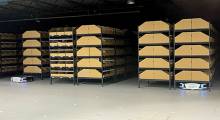The future looks promising for robotic materials handling, according to Henrik Christensen, the Kuka Chair of Robotics at Georgia Tech.
From where he sits, Christensen says we have a ways to go before robotic materials handling is commonly deployed. At the same time, he’s having conversations with a number of leading companies that are exploring the technology for their operations. One of those is a leading provider of wholesale groceries. In fact, a conversation with one of their executives sparked Christensen’s interest in applying robotics to materials handling.
“When I talked to one of their supply chain executives, he told me that only 20% of the logistics chain for food handling is automated,” Christensen says. “At the same time, about 70% of the cost of groceries is tied up in logistics and handling.”
The executive believed there is room to take out up to 10% of the cost of wholesale groceries through the successful application of automation. Given the amount of manual palletizing involved in building mixed SKU pallets, that seemed like a logical place to look. Christensen was intrigued.
Together with the National Institute of Standards and Technology, Georgia Tech launched an annual student competition to do mixed palletizing. The students get real orders from grocery companies like Kroger and Walmart and design an algorithm to robotically build a pallet to deliver to a grocery store.
The designs are first run in a simulation environment; the best algorithms are then run on a robotic system at Georgia Tech. They are also benchmarked against the software that’s currently available from leading providers like, say, Kuka.
As to the competition winners, well perhaps, one day one of those solutions will be incorporate into a commercial package; or, one of the entrants may find themselves working in our industry, designing the next generation of materials handling robots.
“I think there’s a lot of opportunity for these technologies,” says Christensen. “It’s very clear that companies would like to automate more of there processes: they can build more stable pallets and it will make it easier to staff large distribution centers.”
About the Author
Follow Robotics 24/7 on Linkedin
About the Author
Follow Robotics 24/7 on Linkedin
Article topics
Email Sign Up















